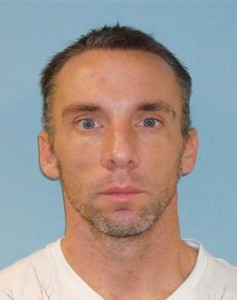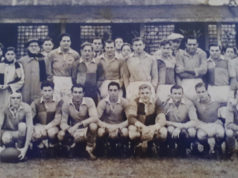When a 12-year-old Labrador retriever named Carly found a human skull near a large creek bed in southeast Austin on Sept. 8, the lower jaw was still attached. Part of a dried scalp filled with buzzed brown hair clung to the skull and part of the left ear. Time — compounded with wind, rain, and the scorching Texas sun — had turned the skull brown and yellow.
Its identity was a mystery. And the skull was missing its body.
But U.S. marshals had a hunch. Based on where the skull was found, the agency thought it could belong to a fugitive named Kevin Patrick Stoeser, who’d been on probation after serving time for sexual molestation of a child and possession of child pornography in Austin. And Stoeser was on the U.S. Marshals Service’s Top 15 Most Wanted list. So identifying the remains became a priority.
A small portion of the bone was cut out of the skull and sent to the University of North Texas Health Science Center in Fort Worth for DNA analysis. All unidentified remains from Texas and most other states are sent to the center.
Health science center team members take DNA from remains and enter that and other information in the National Missing and Unidentified Persons System (NamUs). The DNA profiles in NamUs can then be matched against those in another database — CODIS, run by the FBI — to see if there is a match.

And that’s exactly what happened with the skull Carly dropped in her owners’ front yard. The health science center team was able to pull a DNA profile from the bone in early November. In this case, there was a match in CODIS — the Combined DNA Index System — thanks to the Arlington Police Department.
In June 2002, Stoeser, then a soldier stationed at Fort Hood, was arrested in Arlington for sexual assault of a child. An officer collected DNA from the inside of Stoeser’s cheek with a cotton swab and entered the information in CODIS.
According to the U.S. Marshals Service, Stoeser had a long history of sexual violence, including possession of child pornography, rape, and sexual assault of five children. He pleaded guilty to the Arlington charges of child sexual assault and possession of child pornography and was sent to prison in Kansas, where he served most of a 13-year sentence before being released on probation in 2011.
Sent to a military halfway house in South Dakota, Stoeser ended up back in prison that same year for texting and e-mailing with underage girls, a probation violation. He served a few months, was released again on probation — and again got in trouble almost immediately.
That time he was sent to the Austin Transitional Center, a residential re-entry facility, because he wanted to live closer to his daughter.
Stoeser had been there only a few months when, according to U.S. Marshals Service public affairs deputy Hector Gomez, staffers at the Austin facility found him with a smartphone filled with images of underage kids, and he bolted out an emergency exit. He was 41. Nearby are the creeks and fields where, a year later, Carly is believed to have found the skull.
The health science center works more than 700 unidentified-remains cases each year. About 80 percent of those cases are skeletal remains, said Dixie Peters, technical leader for the missing persons unit within the Center for Human Identification at UNT.
Across the country, there are more than 40,000 cases involving unidentified bodies or skeletal remains. Nearly 10,000 of those cases are active in the NamUs database, making it the largest source of information on unidentified remains in the country. More than 1,000 of those cases are from Texas, including more than 100 added in the last year.
NamUs is a national database that helps match human remains with missing persons cases by keeping information on both. In 2003, the National Institute of Justice (NIJ) created it to allow law enforcement officials and the general public to search through the information. Sometimes it’s the family of missing loved ones, rather than law enforcement, who solves the case, as in a story Fort Worth Weekly covered last year (“From the Land of the Lost,” July 24, 2013).
In 2010 UNT Health Science Center was awarded a grant from the NIJ to take over the management of NamUs, making it a “one-stop shop” for unidentified remains, said B.J. Spamer, director of the training and analysis division of NamUs. The center performs DNA testing, operates NamUs, and partners with the Institute for Forensic Anthropology at UNT’s main campus in Denton to provide insight into the sex, age, and causes of death. Two forensically trained dentists are part of the team, along with analysts who use sites like LexisNexis, Facebook, and Ancestry.com to search for clues to identify remains or possibly locate missing people who are still alive.
“We use the most advanced technology to get the short tandem repeats (STRs),” explained Spamer. STRs are a portion of nuclear DNA that’s passed down from both of an individual’s parents.
On all cases, the ID center processes both nuclear (STR) and mitochondrial DNA, which is inherited from the mother. All siblings from the same mother carry the same mitochondrial DNA.
STR testing is a big deal because “it’s really discriminating,” said Spamer — meaning that the likelihood of another person having that same DNA profile is basically zero.
Every crime lab in the country does STR analysis, Spamer said. But technicians can’t always get an STR profile from human remains because that type of DNA is found in the nuclei of cells and breaks down faster than mitochondrial DNA. A body that’s been exposed to the elements for an extended period of time might not have viable nuclear DNA.
In this case, Peters’ team was able to pull an STR profile from the skull, even though the remains were weathered. And that’s the type of DNA profile that was taken from Stoeser in 2002 and loaded into CODIS. Texas uses STR testing (rather than mitochondrial) when it pulls DNA samples from convicted offenders.
Only nine facilities in the U.S. can perform STR and mitochondrial DNA testing and upload those results into CODIS, Spamer said. UNT Health Science Center provides more DNA profiles on unidentified remains than any other lab in the country. Many private labs can do the DNA testing but don’t have access to CODIS, which is restricted to government-funded facilities.
A few days after Stoeser escaped on Oct. 24, 2013, Austin was hit by what came to be known locally as the “Halloween flood” of 2013. David Fugitt, a homicide detective with the Austin Police Department who worked the case of the recovered skull, believes Stoeser may have drowned in the high waters that killed several other people and ruined many homes.
Stoeser had been missing for more than six months when his case was featured on CNN’s “The Hunt” with host John Walsh, and a $25,000 bounty was offered for information leading to his arrest.
Then in June, the U.S. Marshals Service went back to scour the area again. This time, the search was cut short, Fugitt said, after one investigator was bitten by a rattlesnake and because of heavy rains.
In September, Carly brought home the skull, and the next day, 28 law enforcement officials and four cadaver dogs were back at it, wading through an open field and neighboring creek bed full of waist-high grass, searching for the rest of the missing body.
The team searched throughout the course of the day but found nothing. Law enforcement officials put a tracking device on Carly’s collar and let her roam free for a couple of days, hoping she would take investigators back to the place where she had found the skull. But the dog led them to no more grisly trophies.
Dr. Dana Austin, a forensic anthropologist with the Tarrant County Medical Examiner’s office, said that the instincts of dogs and coyotes to drag bones away to chew on them, combined with the natural decomposition process, make it increasingly less likely that more of Stoeser’s remains will be found.
Carly still might represent the best hope of finding them. Owners Anthony and Bonnie Vin Klarek said the Labrador retriever gets a walk every day through the area where they think she found the skull, and at night she often jumps the fence to forage on her own.
The dog has never brought back another bone, Bonnie said, but a week after finding the skull, “she came back home with a kid’s baseball glove.”
Fort Worth freelance writer Sarah Angle can be reached at sarahlesangle@gmail.com.












